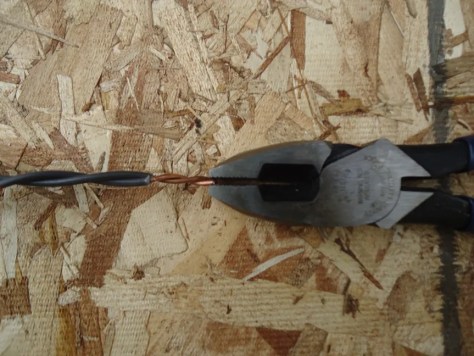How to Install a Wire Nut :: DIY Home Improvement Essential Skills
*******

I remember a few times digging into old boxes or even into walls to find aged electrical wires twisted, sometimes loosely, with nothing more than electrical tape holding them together.
And maybe these are isolated cases, only found by those of us who like to poke around inside of housey things. Or maybe, it was just a way they did it … back then. idk … but this just wasn’t how I came up. Instead, I learned from the beginning that when joining voltage-bearing wires, you use a wire nut.
*******
In this article, we’ll cover both How to Install a Wire Nut for a Light Fixture & How to Install a Wire Nut with Line Voltage. For Line Voltage, the Steps are as follows: (Click to jump to any section as discussed below.)
*******
But how to install a wire nut properly?
It actually took me many years to know.
How to Install a Wire Nut for Light Fixtures
As a punch out guy in the late ‘90s, I installed a ceiling fan, a fixture or two. It was easy enough, I’d make sure the power was off at the switch (though the breaker is better) and I’d install the light. Following the instructions that came in packaging, I’d use the orange wire nuts included in almost every box.
In most cases, it was simple – black to black, white to white and ground to green if I could. You hold the thin wire (usually a #14 or #16 stranded wire for the fixture) just a little long of the (line) wire you are tying into and twist away in a clockwise direction. And this was how I learned.
*******
How to Install a Wire Nut like a Pro :: Line Voltage
* Strip Wire Insulation & Hold Wires Flush
You can do essentially the same thing when tying two voltage-carrying wires together (usually #12 or #14 wire for in-home use). Like most sources suggest, you can start by stripping away about ¾” of insulation (using a wire stripping tool). Then, holding them this time perfectly parallel and flush, again you can twist away. (Yellows or Reds are typically your choice in wire nuts here.)
And that’s exactly how I did it. That is – until I had the opportunity to work side by side with several real life electricians, a few years back.
* Take Side Cutters and Twist in a Clockwise Direction
Every pro electrician I have worked with uses a slightly different method. But packing a pair of 9″ side cutting pliers (aka side cutters), they’d strip (again using a stripping tool) a little long of that 3/4″ mark – 7/8″ say. Then, holding the wire’s ends again flush, but set instead inside the teeth of the pliers, they’d use this tool to do their twisting.
* Snip off Tips & Screw on Wire Nut
Because side cutters are plier-tipped, the tip of wires get marred. But here is the beauty of it, just take those same side-cutters and snip off this damage (yep, about 1/8″). Not only can you now screw your wire nut on effortlessly, you can also be confident that you have a 100% positive and clean connection. Electricians’ Gold!
*******
And there you have it, in my eyes … if you are connecting line to line using a wire nut, it simply can not be done correctly without a good pair of side cutting pliers.
While I usually prefer Ideal‘s wire connectors, here is a best selling assortment on Amazon. A 158-piece for just over $10. Remember to choose the proper size for your job.
This article was originally posted as a partnered post with The Home Depot in conjunction with Klein Tools and featured a giveaway.
About Klein Tools:
- In its 156th year, Klein Tools is the most preferred brand among electrical contractors – according to a recent study, 81 percent said they prefer Klein over any other electrical tool brand.
- Klein is teaming up with the world’s largest home improvement retailer, The Home Depot. Klein Tools is an exclusive partner and brings another iconic American brand into more than 2,200 The Home Depot stores.
- Klein’s existing and future product lines will be available through The Home Depot, where diyers as well as pros will have access to a full suite of offerings including recently released fish tape sets, conduit benders, glow and fish rod sets, electrical testers, hole-making tools and more.
*******
Essential Tool in Focus | Klein’s D213-9NE (on Amazon @ around $30):
- Known as “Kleins,” these pliers are made from custom, U.S. tool steel and combine precision with durability.
- The high-leverage design and unique rivet placement creates 46 percent greater cutting and gripping power than other plier designs.
- Hot riveted joint ensures smooth action and no hand wobble, while handform handles enable full gripping and cutting power.
Good luck & thanks for reading. For additional articles on Essential Skills, please see our Skills category. For more on working with Electrical, well, well our Electrical category. Cheers. ~jb
















thanks. i thought i was doing something wrong when working on existing splices i would sometimes see them twisted solidly together under the wirenut. like this post demonstrates. now i know how to do it!
Doug appreciate your comment… worked with a number electricians through the years. They seem to always pull it off more gracefully, but either way – it’s always pre-twist. Cheers. ~jb
Thanks. This is very helpful. I occasionally do electrical work around my house and wanted be sure I was using the proper technique. This is so much easier and reliable then trying to do it by hand.
“side cutting pliers”, or “side-cutters” are wire cutters of the “diagonal plier” variety; what you show, wire-cutter with gripping tip, is commonly called “linesman pliers”.